Understanding how effectiveness works in the digital age has become the mission of modern marketers. We cover this in detail in our Toolkit 2017 of Marketing Trends, which includes a whole chapter on the subject.
The current debate
One of the marketing world's fiercest debates is how best to use brand strategy on digital platforms.
The debate gained strength when Procter & Gamble announced they were stepping back from granular targeting on Facebook and refocusing on reach (and they're not the only ones)
Marc Pritchard, Global Brand Building Officer at Procter & Gamble, has said: 'Our brands have to be top of mind. What we're trying to do is to reach enough people with enough frequency to get them to buy with the best quality'.
But why did the P&G decision cause such a stir? Simply because it went against what many would argue is the core benefit of digital - its ability to offer targeted and personalised communications and to respond in the moment.
Insights from Les Binet
During a recent Warc Webinar, Les Binet, Head of Effectiveness at Adam & Eve, DDB, shed light on how the digital world is really evolving and what have been demonstrated to be the most effective strategies to follow.

Apart from his day job at adam&eveDDB, Binet has been (along with Peter Field) one of the leading thinkers behind a collection of reports commissioned by the IPA (UK) for over 10 years. Together, Binet and Field have been comparing and analysing effectiveness data and looking into how brands are operating across different platforms.
Effectiveness works in two ways
The fundamental idea at the core of their research is that effectiveness works in two ways.
On the one hand, there is brand building. The essence is to create memory patterns on people to make them feel good about the brand. These people won't necessarily buy in the moment, but rather in the future. Each exposure to a brand building campaign creates incremental effects which produce long term sales growth.
On the other hand, there is sales activation. Unlike brand building, the aim here is to stimulate sales by identifying the people who are shopping in the moment and making them buy right now. That requires a much more targeted approach and smaller budgets. When done properly the strategy results in high sales in the short term, but these decay over time.
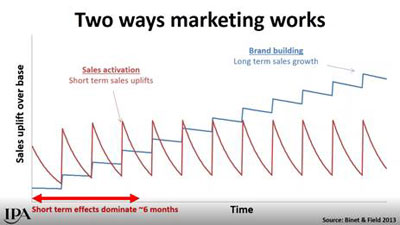
So, in summary, brand building has the biggest long term effect, while sales activation stimulates short term sales.
"Many marketers tend to think that the key to effectiveness is sales activation, which has become the dominant model for a lot of digital activity, but it is actually brand building that drives the long term sales of a brand".
The truth is you need both these approaches to work together in balance. And understanding both long term and short term effectiveness is key.
A new orthodoxy?
Recently, a well-known marketing authority (unnamed by Binet) proclaimed the death of mass marketing, assuring instead that we are living a 'new orthodoxy' and stating that 'brands need to move away from mass marketing to having more direct, personal relationships with their buyers'.
But are loyalty strategies the way to go? It doesn't seem like it. Binet's research showed that loyalty strategies still underperform, with barely a change in numbers compared to ten years ago. In fact, loyalty only tends to increase when penetration increases.
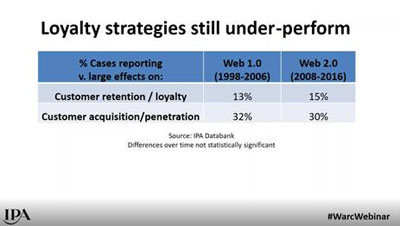
"So it seems like marketing is still very much, a numbers game".
It all comes down to what a brand decides to prioritise - if it's short term sales and responses, it's unlikely it will achieve long term growth.
"Market share growth is one of the biggest predictors of the long-term success of a brand. The more you move away on focusing from your existing customer to talk to the whole market, the more successful your campaign is".
It seems like reach is still the main driver behind long term growth. But how do we achieve this?
The three media components
We can distinguish three types of media - paid, owned and earned. According to Binet "smart brands use all of those three components of the mix together".
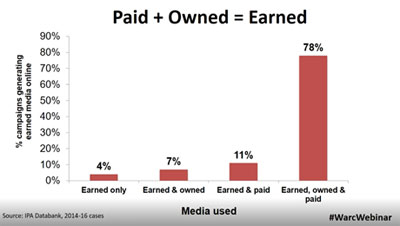
Earned and owned media do make marketers work harder of course. Earned media doesn't really come for free - getting people to talk and share content are the result of investment. But to get significant earned media, paid and owned media must work together.
So what can we learn from this? "Budgets still matter, particularly online". Binet contends that "budgets are more important in the digital world than they ever used to be". That might seem paradoxical to some, but he believes "it's to do with the way in which online channels have amplified the effects of every pound you spend".
It turns out not only the 'new orthodoxy' seems to be wrong, but on the contrary the digital revolution makes how much marketers spend actually matter twice as much.
TV and online video work in synergy
Another interesting fact to consider is how people consume media on a comparable basis. It's been demonstrated that, when brands use online video and TV work in synergy they experience the biggest uplift - up to 54%. "TV is great for effectiveness, what online video does then is increase the efficiency of TV". It's the best of both worlds".
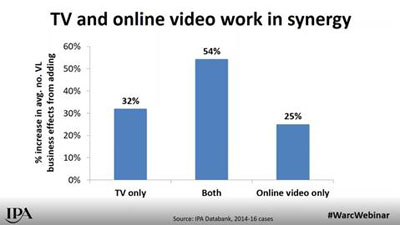
Digital seems to make mass media more effective
Binet believes those synergies between online and offline media probably exist throughout all media. "Far from mass media being dead, it seems that the digital revolution has made mass media work better, because of that targeted digital activation supporting broad reach media on and offline".
So, brands will be relieved to know any competition between targeting and reach is in fact, a need to work together. These findings are tremendously positive.
The dangerous attraction of ROI
There are however, a series of threats that could just about destroy a brand in a matter of months, and the most concerning one is the struggle to differentiate between ROI and profit. Focusing on ROI tends to lead people to cut budgets, growth and profit.
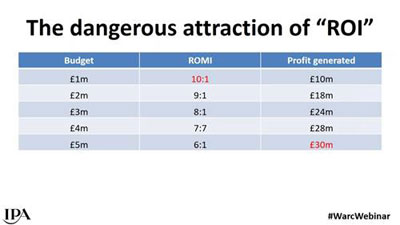
But surely, if you maximize your ROI you're maximizing profit? This is not the case. Profit needs higher budgets. "ROI can be maximized with small budgets. But these campaigns will tend to have falling sales and profits in the long term".
What does this show us?
Some brands are cutting budgets, getting the balance between long and short term wrong and, consequently, obtaining worse business results.
Binet believes "the potential effect of mass media is greater than it's ever been, but we need to use those tools in balance. Smart marketers need to understand that targeted [advertising] has a role to play but reach makes the targeted stuff work. That online media is great for converting prospects, but that broad mass media still has a role to warm up that stuff".
So in the end, it just comes to show "it's all about getting that balance right".
Want to know more?
- Read the full Toolkit chapter on Effectiveness in the Digital Age
- Read our 6 rules for brand success in the digital age
- Watch the recording of the Webinar

